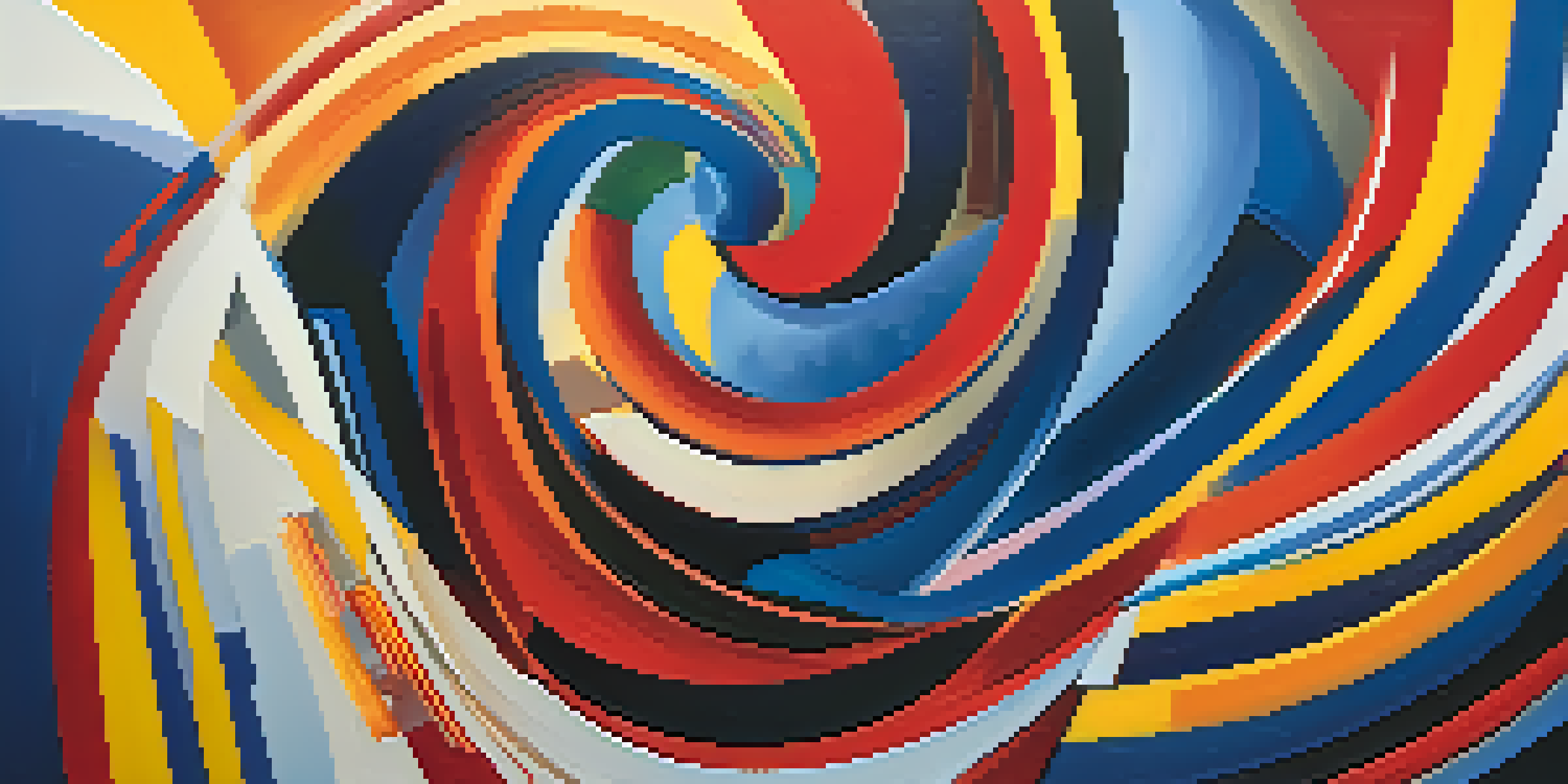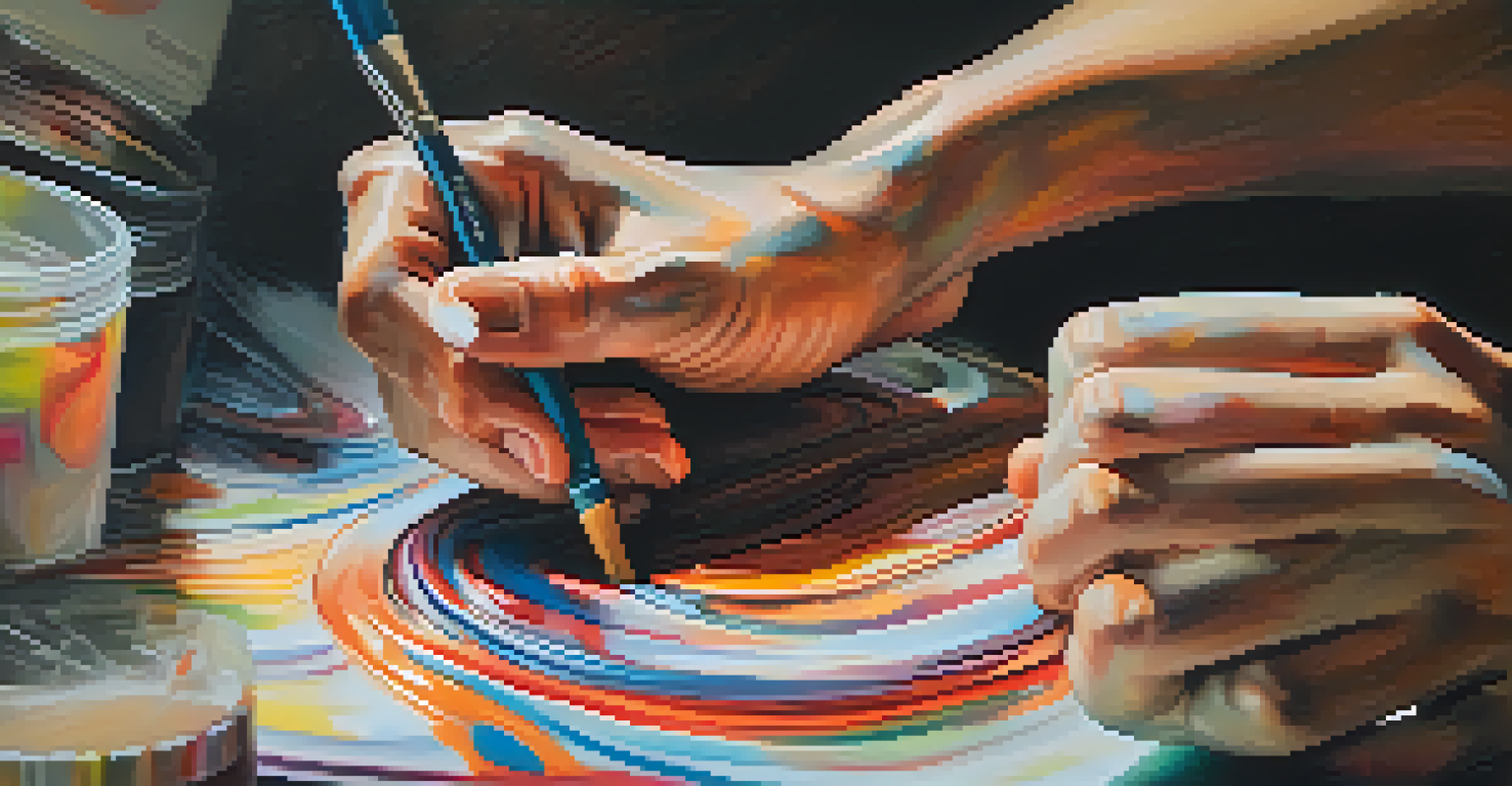The Connection Between Abstract Art and Modernism

Understanding Abstract Art: A Brief Overview
Abstract art is a movement that emerged in the early 20th century, focusing on the use of shapes, colors, and forms rather than direct representation. Unlike traditional art, where the subject is easily identifiable, abstract art invites viewers to interpret and experience the artwork on a more emotional level. This unique approach allows for a diverse range of expressions, encouraging artists to break free from the confines of realistic representation.
Color is the keyboard, the eyes are the harmonies, the soul is the piano with many strings.
One of the pioneers of abstract art, Wassily Kandinsky, believed that colors and shapes could evoke emotions in ways that tangible subjects could not. His work exemplifies how abstract art prioritizes feelings and perceptions over realism. This shift in focus laid the groundwork for the modernist movement, which sought to challenge and redefine artistic conventions.
In essence, abstract art serves as a bridge to modernism, fostering creativity and experimentation. As artists began to explore new ideas and techniques, they opened the door for a slew of modernist movements, each with its own unique characteristics and philosophies.
The Rise of Modernism: A Cultural Shift
Modernism emerged in the late 19th and early 20th centuries as a response to the rapid changes in society, technology, and culture. Artists, writers, and thinkers sought to break away from traditional forms and explore new ways of expressing their ideas. This cultural shift was marked by a sense of disillusionment, as the old values seemed inadequate in the face of modern life's complexities.

At the heart of modernism is the idea of innovation and progress, which resonates strongly with the principles of abstract art. Both movements encourage artists to explore unconventional methods and challenge established norms. This shared ethos has led to a rich interplay between abstract art and modernist philosophy, influencing countless artists and movements across the globe.
Abstract Art Invites Personal Interpretation
Unlike traditional art, abstract art encourages viewers to connect emotionally and interpret the artwork uniquely.
As modernism gained momentum, it began to permeate all facets of culture, from literature to architecture. The connection between abstract art and modernism became increasingly evident, as both sought to reflect the changing realities of contemporary life and suggest new ways of seeing the world.
Key Figures in Abstract Art and Modernism
The landscape of abstract art and modernism is dotted with influential figures who have shaped the course of both movements. Artists like Piet Mondrian and Kazimir Malevich pushed the boundaries of abstraction, experimenting with geometric forms and color theory. Their work not only challenged traditional artistic practices but also inspired future generations to rethink their creative approaches.
I am interested in the relationship between the individual and the group, between the abstract and the concrete.
In literature, modernist writers like Virginia Woolf and James Joyce adopted stream-of-consciousness techniques, paralleling the ways abstract artists sought to convey complex emotions. These pioneers demonstrated that art and literature could both transcend the mundane, offering new perspectives through abstraction and innovative narrative structures.
The synergy between these key figures illustrates the interconnectedness of abstract art and modernism. Their contributions not only defined their respective fields but also helped to cultivate a broader cultural dialogue about the role of art in society.
The Emotional Impact of Abstract Art
One of the most compelling aspects of abstract art is its ability to evoke strong emotional responses from viewers. Unlike traditional art, which often conveys a clear narrative or subject, abstract art invites a more personal interpretation. This openness allows individuals to connect with the artwork on a deeper level, making their experience unique and subjective.
For example, consider how a vibrant splash of color might elicit feelings of joy, while a dark, chaotic composition could evoke anxiety. Abstract art relies on the viewer’s emotions and perceptions, making it a powerful tool for self-reflection and introspection. This emotional connection is a hallmark of modernist ideals, which prioritize personal experience over objective reality.
Modernism Influences Artistic Innovation
Both abstract art and modernism thrive on experimentation, pushing artists to explore unconventional methods and challenge norms.
As modernism continues to evolve, the emotional impact of abstract art remains relevant. Artists today still explore the depths of human experience, using abstraction as a means to articulate complex feelings and ideas that resonate with contemporary audiences.
The Role of Experimentation in Both Movements
At the core of both abstract art and modernism lies a spirit of experimentation. Artists are encouraged to push boundaries, explore new materials, and adopt innovative techniques. This willingness to take risks has led to groundbreaking works that challenge perceptions and provoke thought, fostering a culture of continuous evolution within the art world.
For instance, the use of mixed media and unconventional materials has become a hallmark of modernist and abstract works. Artists like Robert Rauschenberg, known for his combines, blurred the lines between painting and sculpture, showcasing the limitless possibilities of artistic expression. This experimentation fosters creativity and encourages artists to explore their unique voices.
Ultimately, the role of experimentation in both movements highlights the dynamic nature of art. As artists continue to innovate, they create new connections between abstract art and modernism, ensuring both remain relevant in today’s ever-changing cultural landscape.
The Influence of Abstract Art on Contemporary Artists
Today, the influence of abstract art can be seen in the work of contemporary artists who draw inspiration from its principles. Many modern artists incorporate abstraction into their practice, allowing them to explore complex themes such as identity, culture, and politics. This blending of ideas shows how the legacy of abstract art continues to shape the artistic landscape.
For example, artists like Julie Mehretu and Mark Bradford create large-scale abstract works that address social issues through their unique visual language. By combining abstraction with narrative elements, they invite viewers to engage with their work on multiple levels. This approach reflects the ongoing relevance of abstract art within the context of modernism.
Legacy of Abstraction in Contemporary Art
Contemporary artists continue to draw inspiration from abstract art, addressing complex themes while engaging audiences on multiple levels.
Moreover, the accessibility of abstract art has encouraged a new generation of creators to experiment with their own interpretations. As they navigate the complexities of contemporary life, these artists continue to contribute to the dialogue between abstract art and modernism, ensuring its place in the future of art.
Conclusion: The Enduring Connection Between Abstract Art and Modernism
The relationship between abstract art and modernism is a fascinating exploration of creativity, emotion, and innovation. Both movements challenge traditional boundaries, encouraging artists to experiment with new ideas and forms. This interconnectedness has shaped the trajectory of art, influencing countless creators and inspiring new generations to explore their artistic potential.
As we reflect on the enduring legacy of abstract art and modernism, it’s clear that their impact resonates beyond the canvas. They invite us to question our perceptions, embrace uncertainty, and find beauty in the unfamiliar. This shared ethos continues to inspire artists and audiences alike, fostering a deeper appreciation for the power of art.

In conclusion, the connection between abstract art and modernism is not just a historical narrative; it’s a living dialogue that continues to evolve. By celebrating this relationship, we can better understand the diverse expressions of creativity that enrich our world and connect us all.